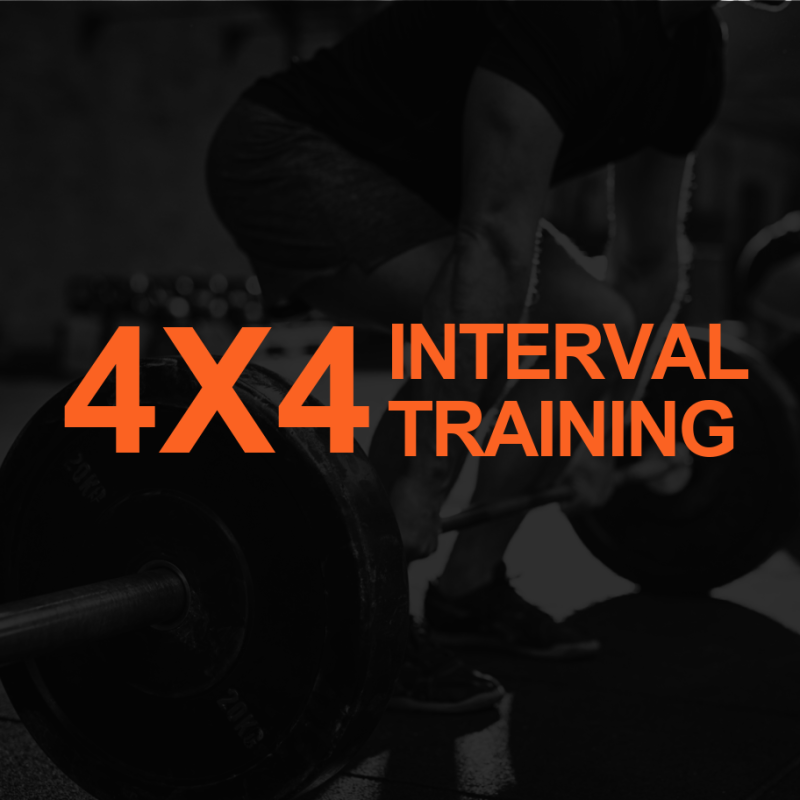
In the fitness industry, professional trainers can design and support four-by-four (4×4) exercise protocols that are time efficient and promote both durable and strong characteristics in clients of nearly all ages and abilities. The following details two proven 4 by 4 exercise protocols for interval training, with specific merits and considerations to improve stamina or strength in quick effective workouts.
First, a refresher on intervals.
High-intensity Exercise Will Boost Health
“The inclusion of ‘adapted’ high-intensity (relative to a subject’s current physical ability) in a client’s exercise protocol is a key component for exercise to be more efficient as a ‘medicine.’”1
- A research group for one of the healthiest nations on earth [Norway] provides global exercise advice and programs for longevity. This source provides your first 4×4 interval training for durability or stamina.
- Earlier NFPT articles for High-Intensity Interval Training (HIIT) and REHIIT specified tailored and quick workouts that can “lead to increased caloric expenditure, improved aerobic efficiency, increased lean mass, improved power, and – there are even brain benefits!” These will serve as the bases for your second 4×4 protocol for strength.
A Durable 4 x 4 for Stamina and VO2 Max
A Norwegian research laboratory, the Cardiac Exercise Research Group, or CERG, is a known leader in optimizing exercise for good health and longevity and measuring VO2 max provides a measure of such.
CERG researchers are cognizant of time constraints that can inhibit people’s successful habits to achieve health and longevity. Thus, this effective 4×4 stamina workout can be completed in about 28 minutes (excluding warmup and cooldown.)
These experts recommend 4×4-minutes interval training to improve fitness and offer a free online video explaining how and why you should perform this type of exercise. This quick and efficient training approach can entail running, biking, or other stamina activities.
This interval training is optimal when an intensity of 85–95 % of her or his maximum heart rate is sustained during the four 4-minute exercise segments. And, the client should remove lactate most efficiently at 70% of that current maximum heart rate (MHR) during the three rest periods. The client can resume the next interval work when heart rate recovery is reached, or when about two minutes elapse.
Example: If a client’s (measured) MHR is 160 beats per minute, then their rest period heart rate should drop to at least 112 bpm. The next phase can begin at that HR level, or when about two minutes has elapsed. Recall that every client’s recovery heart rate is unique.
Many people may hold this misinformed belief that all HIIT involves taking intensity to 100% effort and wearing themselves out until they collapse. This is not the practice of 4×4 interval training. In fact, those with coronary artery disease have show great success with this type of exercise. As always, anyone with contraindications should get clearance from a medical provider.
Calculating Maximum Heart Rate
- Test maximum heart rate (MHR):
- Warm up thoroughly so you start sweating.
- Do two intervals, each four minutes long. During the intervals you should be too short of breath. Walk slowly for three minutes between the intervals.
- Start the third interval, but two minutes in, run as fast as you can until you’re too exhausted to continue. Your maximum heart rate will be the highest heart rate you reach.”
- If a client’s goal is to increase physical fitness and endurance capacity, “we recommend 2–3 sessions with interval training per week.”
4×4 Strength Regimen
This hybrid “4 squared” resistance workout sequences a client through the following in a short time period.:
a. power
b. hypertrophy
c. strength
d. endured strength/high repetitions
It may take your client and you a few sessions to “peg” correct resistance loads, based on 1RM. While the stamina 4 x 4 training is measured in minutes, the strength 4×4 only measures repetitions. Thus, the strength 4×4 can be completed for a compound lift, or isolated muscle group action in just a few minutes.
While this protocol can be used for isolated muscles, the example here is for a complex resistance move, the conventional deadweight.
“Choosing the right load is key because you want to reach each rep target near muscle failure… a Bodybuilding.com rep calculator (2) can help you determine your one-rep max (1RM) which you can then use to calculate the other RMs – 4RM, 8RM, 12RM, and 16RM.
Example:
A woman’s recent 1RM for the deadlift is 180 pounds.

1.The first segment is powerlifting of four (4) repetitions. Her 4 repetitions should be at about 140-160 pounds (with proper form.). The time spent in the three phases of a deadlift is variable. One possible approach is a slow 3-second eccentric lowering of the bar, an immediate return lift back to standing for 2 seconds, and a 1-second pause at the top end phase of the repetition. If this 3-2-1 timing protocol is used, the powerlift segment takes only 30 seconds. Her rest periods between lifting segments are minimal, perhaps 30-60 seconds.
2. The second segment involves hypertrophy and strength dead-ifting of a slightly lighter weight for 8 repetitions. In this example, the lifter should use about 120-140 pounds.
3. The third segment also focuses on hypertrophy and strength for 12 repetitions (with proper form.). Her 12RM deadweight is decremented slightly, to about 1/2 to 2/3rds of current 1RM, or 90 to 120 pounds.
4. The fourth and final phase of this hybrid protocol is an “endured strength” set of 16 repetitions using ~ 1/3 to 1/2 of her current 1 RM.
Of course, this 4×4 strength protocol can be sequenced for other complex lifts or isolated muscle groups in a total resistance workout.
Considerations
“For general health and primary and secondary cardiovascular prevention, high-intensity interval training (HIIT) has been recognized as an efficient exercise protocol with short exercise sessions.”1
Both the stamina 4×4 and the strength 4-squared workouts are quick interval-type fitness workouts. Clients should experience true gains and challenge their capacity from twice-weekly 4 x 4s. Safety is paramount, yet a key takeaway is that these 4x4s are suitable for athletes of all ages and capabilities (with medical approval.)
Why not experience the “HIIT” of a 4×4?
References
- Ito S. High-intensity interval training for health benefits and care of cardiac diseases – The key to an efficient exercise protocol. World J Cardiol. 2019 Jul 26;11(7):171-188. doi: 10.4330/wjc.v11.i7.171. PMID: 31565193; PMCID: PMC6763680.
- https://www.bodybuilding.com/fun/other7.htm






